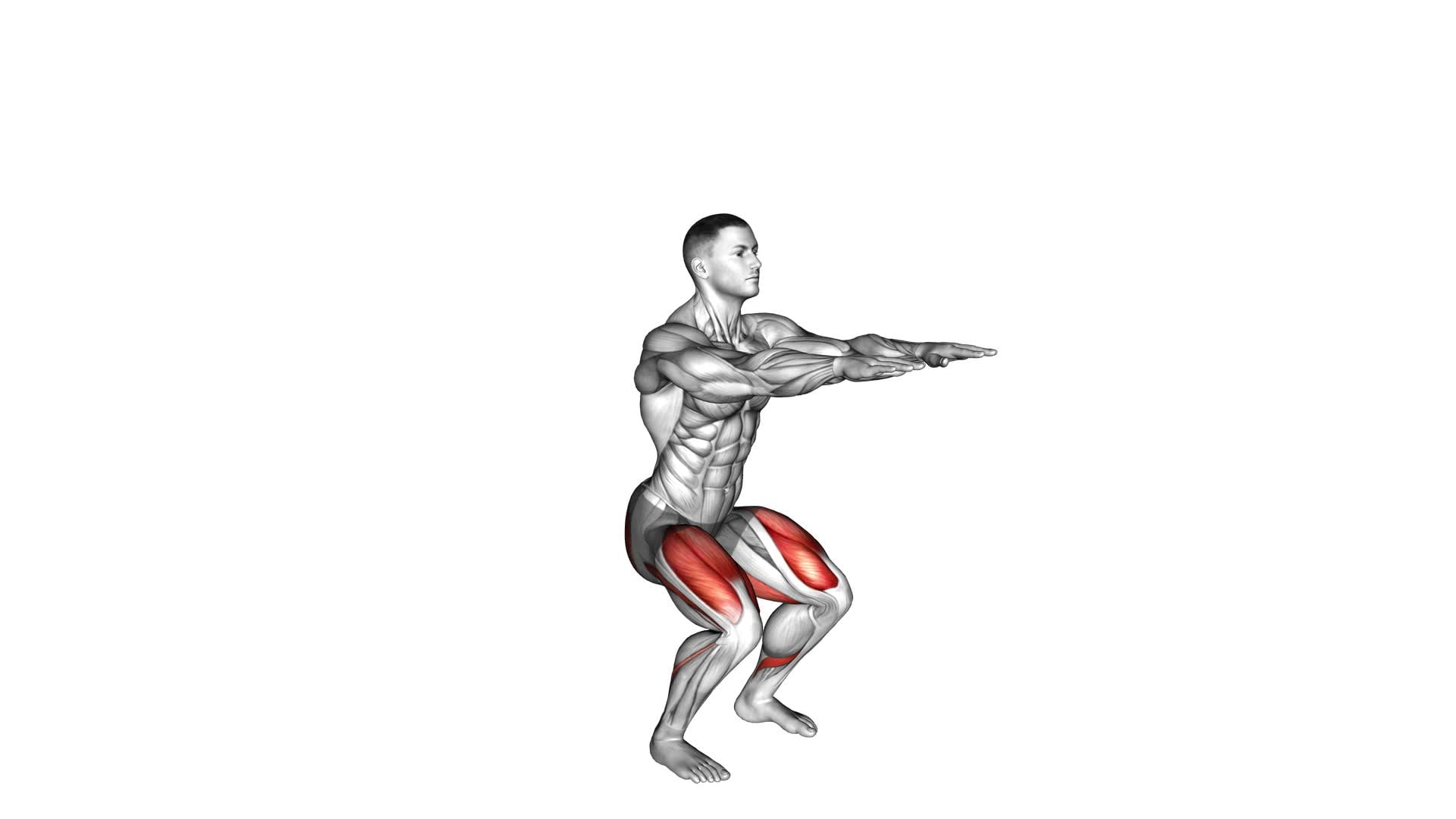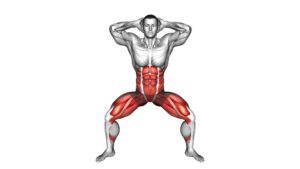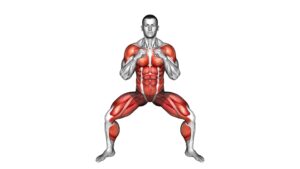Bodyweight Half Squat (male) – Video Exercise Guide & Tips

Are you looking for an effective lower body exercise? The bodyweight half squat is a great option for you! This exercise targets your quadriceps, glutes, and hamstrings, helping you build strength and improve your overall fitness.
Watch This Exercise Video
In this article, we will provide you with a video exercise guide and valuable tips to ensure you perform this exercise correctly.
Get ready to amp up your workout routine and achieve your fitness goals with the bodyweight half squat!
Key Takeaways
- Bodyweight half squats build lower body strength and tone quadriceps, hamstrings, and glutes.
- Proper form and technique, such as maintaining knee alignment and engaging glutes, are crucial for maximizing muscle activation and reducing the risk of injury.
- There are variations and progressions of bodyweight half squats, such as using dumbbells or incorporating explosive movements, to increase difficulty and target different muscle groups.
- Safety precautions, including warming up, gradually progressing intensity, and listening to the body to avoid pain or injury, are important when performing bodyweight half squats.
Benefits of Bodyweight Half Squat for Males
Discover the numerous benefits you can experience from incorporating bodyweight half squats into your fitness routine as a male. Bodyweight half squats offer a range of advantages for both men and women.
Firstly, they're a great exercise for building lower body strength. By engaging the quadriceps, hamstrings, and glutes, bodyweight half squats help to tone and strengthen these muscle groups. Additionally, this exercise also improves balance and stability, as it requires core engagement to maintain proper form.
For women, bodyweight half squats provide additional benefits such as improving bone density and reducing the risk of osteoporosis. This is because the exercise places stress on the bones, promoting bone growth and strengthening. Furthermore, bodyweight half squats can be modified to suit different fitness levels.
Beginners can start with a shallow squat, gradually increasing the depth as they become more comfortable and stronger. Those at an intermediate level can add resistance by holding weights or using resistance bands. Advanced individuals can challenge themselves with explosive jumps or plyometric variations of the exercise.
Incorporating bodyweight half squats into your fitness routine as a male can help you achieve a stronger lower body, improve balance and stability, and even enhance bone density. Now that you know the benefits, it's time to learn about the proper form and technique for bodyweight half squats.
Proper Form and Technique for Bodyweight Half Squat
To perform a bodyweight half squat with proper form and technique, you should start by standing with your feet shoulder-width apart. This is the starting position for the exercise.
Now, let's move on to the proper form and technique for executing the bodyweight half squat:
- Bend at the knees: Lower your body by bending your knees, making sure to keep your back straight and your chest lifted. Imagine sitting back into an imaginary chair.
- Go halfway down: As the name suggests, the bodyweight half squat involves going only halfway down. This means your thighs should be parallel to the ground, creating a 90-degree angle at your knees.
- Engage your glutes and quads: Focus on engaging your glutes and quads as you push through your heels to return to the starting position. This helps to strengthen these muscle groups.
- Maintain proper alignment: Throughout the exercise, keep your knees aligned with your toes and avoid letting them collapse inward. This helps to protect your knees from injury.
Common misconceptions: One common misconception is that the bodyweight half squat isn't effective because it doesn't involve a full range of motion. However, this exercise can still provide significant benefits, such as strengthening the lower body and improving stability.
Variations and alternatives: If you want to increase the difficulty of the exercise, you can try performing the bodyweight half squat with dumbbells or a barbell. Alternatively, you can also try other squat variations, such as the goblet squat or the Bulgarian split squat, to target different muscle groups.
Common Mistakes to Avoid During Bodyweight Half Squat
When performing the bodyweight half squat, it's crucial to pay attention to your knee alignment. Incorrect knee alignment can put unnecessary stress on your joints and increase the risk of injury.
To maintain proper form, ensure that your knees are tracking in line with your toes throughout the entire movement. By focusing on knee alignment, you can optimize the effectiveness of the exercise and reduce the likelihood of experiencing any discomfort or injury.
Knee Alignment Importance
To ensure proper knee alignment during the bodyweight half squat, it's crucial that you focus on maintaining a strong and stable position. Proper knee alignment is important for several reasons, including the importance of knee stability and its impact on overall lower body strength.
Here are four key reasons why knee alignment is important during the bodyweight half squat:
- Reduce the risk of injury: Maintaining proper knee alignment helps to reduce the risk of injuries such as strains, sprains, and knee pain.
- Maximize muscle activation: Proper knee alignment ensures that the correct muscles are being targeted and activated during the exercise, maximizing the effectiveness of the movement.
- Improve exercise efficiency: When your knees are properly aligned, you can perform the bodyweight half squat with better form and technique, making the exercise more efficient and effective.
- Enhance overall lower body strength: Proper knee alignment allows you to engage the muscles in your lower body more effectively, leading to increased strength and power.
Maintaining Proper Form
To maintain proper form during the bodyweight half squat, focus on avoiding common mistakes that can hinder your performance and results.
One common mistake to avoid is letting your knees collapse inward during the movement. This can put unnecessary stress on your knee joints and increase the risk of injury. To prevent this, make sure to keep your knees aligned with your toes throughout the exercise.
Another mistake to watch out for isn't reaching a deep enough squat position. Going only halfway down can limit the effectiveness of the exercise and prevent you from fully engaging your muscles. Aim to lower your hips until your thighs are parallel to the ground to get the most out of the bodyweight half squat.
Tips to Increase the Intensity of Bodyweight Half Squat
To enhance the intensity of your bodyweight half squat, incorporate resistance bands into your workout routine. Resistance bands provide an added challenge by increasing the difficulty of the exercise. Here are four tips to help you increase the intensity of your bodyweight half squat:
- Use thicker resistance bands: Thicker bands offer more resistance, making your muscles work harder during the squat. Start with a lighter resistance band and gradually increase the thickness as you get stronger.
- Add a pause at the bottom: When you reach the halfway point of the squat, hold the position for a few seconds before returning to the starting position. This pause will engage your muscles for a longer period, intensifying the exercise.
- Increase the number of reps: Instead of performing the standard 10-12 reps, aim for a higher number of repetitions. This will challenge your muscles and increase the overall intensity of the exercise.
- Incorporate plyometric variations: Plyometric exercises involve explosive movements that can further enhance the intensity of your bodyweight half squat. Try adding jump squats or squat jumps to your routine for an added challenge.
Modifications and Progressions for Bodyweight Half Squat
Now that you have mastered the basic bodyweight half squat, it's time to explore some modifications and progressions to challenge yourself further.
For beginners, you can start by using a chair or bench to assist with balance and stability during the exercise.
As you become more advanced, you can incorporate additional resistance by holding dumbbells or using a barbell for added intensity.
Beginner Modifications
Start by adjusting the depth of your half squats to make them more accessible for beginners. Here are some beginner modifications and common mistakes to avoid:
- Decrease the depth: Instead of going all the way down to parallel, start by squatting to a comfortable depth where you can maintain proper form. As you build strength and confidence, gradually increase the depth.
- Use a support: If you struggle with balance or stability, hold onto a sturdy object like a chair or wall for support. This will allow you to focus on your form and gradually build strength.
- Slow down the tempo: Instead of performing the half squats quickly, slow down the movement to enhance control and stability. This will also help you engage your muscles more effectively.
- Focus on form: Pay attention to your posture throughout the exercise. Keep your chest up, shoulders back, and knees in line with your toes. Avoid rounding your back or letting your knees collapse inward.
By implementing these modifications and avoiding common mistakes, you can safely and effectively perform bodyweight half squats as a beginner.
Now, let's move on to the next section and explore advanced progressions.
Advanced Progressions
As you advance in your bodyweight half squat training, you can incorporate modifications and progressions to challenge yourself further.
One advanced variation you can try is the pistol squat. This exercise requires you to balance on one leg while lowering your body down into a single-leg squat position. Not only does it increase the difficulty of the movement, but it also enhances muscle activation in your quads, glutes, and core.
Another advanced progression is adding a jump to your half squat. This explosive movement not only targets your lower body muscles but also improves power and explosiveness. To perform this variation, start in the half squat position and then explode upward, jumping as high as you can.
These advanced variations will take your bodyweight half squat training to the next level, challenging you both physically and mentally.
Safety Precautions and Considerations for Bodyweight Half Squat
To ensure your safety while performing the Bodyweight Half Squat exercise, it's essential to be mindful of certain precautions and considerations. Follow these safety precautions and injury prevention tips to minimize the risk of accidents or injuries:
- Warm-up: Before starting any exercise, including the Bodyweight Half Squat, it's crucial to warm up your muscles and joints. This helps increase blood flow and flexibility, reducing the chances of strain or injury.
- Proper form: Maintaining proper form is vital for preventing injuries during the Bodyweight Half Squat. Keep your feet shoulder-width apart, knees aligned with your toes, and weight evenly distributed on your heels. Avoid rounding your back or letting your knees collapse inward.
- Gradual progression: If you're new to the Bodyweight Half Squat or haven't exercised in a while, start with lower intensity and gradually increase the difficulty. This allows your muscles and joints to adapt and reduces the risk of overexertion or strain.
- Listen to your body: Pay attention to any pain or discomfort during the exercise. If you experience sharp or prolonged pain, stop immediately and consult a healthcare professional. Pushing through pain can lead to further injury.
Frequently Asked Questions
Can Bodyweight Half Squats Help Me Build Muscle in My Legs?
Bodyweight half squats are a great way to build muscle in your legs. By performing this exercise, you engage your quadriceps, hamstrings, and glutes, which leads to increased muscle strength and size.
Additionally, bodyweight half squats are a convenient and accessible option, as they require no equipment and can be done anywhere.
If you're looking for alternatives, you can try weighted squats or lunges to further challenge your leg muscles and continue building strength.
How Many Reps and Sets Should I Do for Bodyweight Half Squats?
To determine the number of reps and sets for bodyweight half squats, consider your fitness level and goals. Start with 3 sets of 10-12 reps, with a one-minute rest between sets. As you become more comfortable, gradually increase the number of reps or sets.
Bodyweight half squats are a great way to strengthen your legs and improve lower body stability. They target the quadriceps, hamstrings, and glutes, and can also enhance overall balance and mobility.
Can Bodyweight Half Squats Help Improve My Vertical Jump?
Bodyweight half squats can definitely improve your vertical jump and overall explosiveness. This exercise targets your lower body muscles, such as the quads, glutes, and hamstrings, which are essential for generating power and height in your jumps.
By incorporating bodyweight half squats into your training routine, you can strengthen these muscles, improve your leg drive, and ultimately enhance your athletic performance.
Athletes can benefit greatly from this exercise as it helps to develop the explosive strength required for various sports movements.
Is It Safe to Do Bodyweight Half Squats if I Have Knee Pain or a Knee Injury?
If you're experiencing knee pain or have a knee injury, it may not be safe for you to do bodyweight half squats. These exercises put pressure on the knees and can exacerbate any existing pain or injury.
Instead, try other bodyweight exercises that are less strenuous on the knees, such as lunges or step-ups. You can also consider consulting with a healthcare professional or a physical therapist for alternative exercises that will be safe for your knees.
Can Bodyweight Half Squats Be Incorporated Into a Full-Body Workout Routine?
Incorporating bodyweight half squats into a full-body workout routine can offer several benefits and considerations.
This exercise targets your quads, hamstrings, and glutes while also engaging your core muscles.
To properly perform bodyweight half squats for maximum results, start by standing with your feet shoulder-width apart, then lower your body halfway down into a squat position while keeping your weight on your heels.
Remember to maintain proper form and listen to your body, especially if you have any knee pain or injury.
Conclusion
In conclusion, the bodyweight half squat is a highly effective exercise for males that offers numerous benefits, such as strengthening the lower body muscles and improving overall stability. By maintaining proper form and avoiding common mistakes, individuals can maximize the effectiveness of this exercise.
To increase intensity, incorporating modifications and progressions can be beneficial.
Lastly, it's important to prioritize safety by considering any necessary precautions before engaging in the bodyweight half squat.

Author
Years ago, the spark of my life’s passion ignited in my mind the moment I stepped into the local gym for the first time. The inaugural bead of perspiration, the initial endeavor, the very first surge of endorphins, and a sense of pride that washed over me post-workout marked the beginning of my deep-seated interest in strength sports, fitness, and sports nutrition. This very curiosity blossomed rapidly into a profound fascination, propelling me to earn a Master’s degree in Physical Education from the Academy of Physical Education in Krakow, followed by a Sports Manager diploma from the Jagiellonian University. My journey of growth led me to gain more specialized qualifications, such as being a certified personal trainer with a focus on sports dietetics, a lifeguard, and an instructor for wellness and corrective gymnastics. Theoretical knowledge paired seamlessly with practical experience, reinforcing my belief that the transformation of individuals under my guidance was also a reflection of my personal growth. This belief holds true even today. Each day, I strive to push the boundaries and explore new realms. These realms gently elevate me to greater heights. The unique combination of passion for my field and the continuous quest for growth fuels my drive to break new ground.



